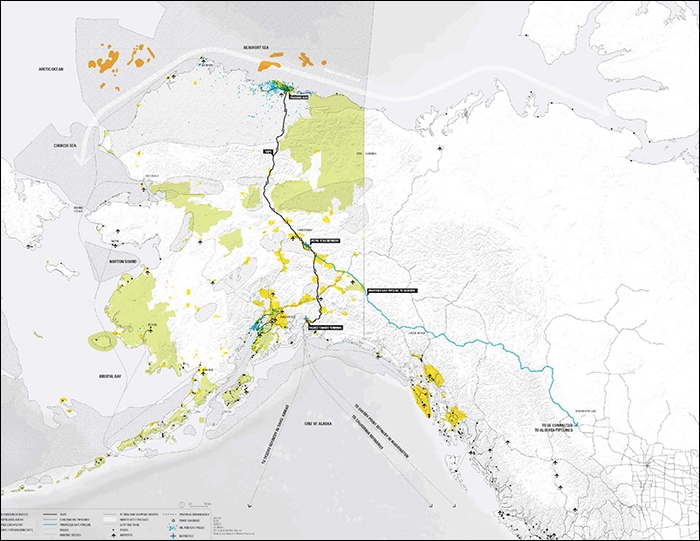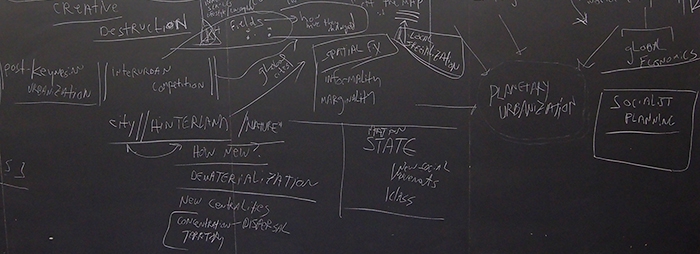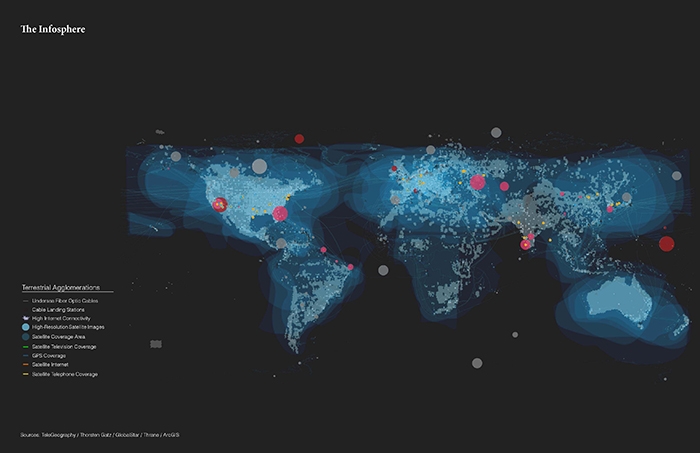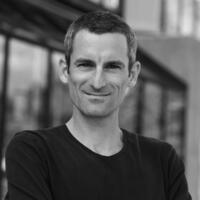How Harvard’s Neil Brenner and the Urban Theory Lab are Changing the Urban Game

Image 1: The “dots-on-map,” urban/rural divide, which is commonly derived from and disseminated through recent UN data and images. Researchers in the Urban Theory Lab-GSD warn against such compartmentalized approaches. (Source: Redrawn from UN-DESA-PD, 2012: accessed 14 June 2012)
Moving away from a city-centric approach to the urban condition, critical urban theory is asking new questions and broadening horizons for the field of urban studies.
More than 20,000 people from 142 countries gathered this April at the 7th annual World Urban Forum (WUF7) hosted in Medellín, Colombia, to discuss the path to sustainable and equitable urbanization. Urban planners, economists, environmental scientists, heads of state, local community leaders, members of the private sector, consortiums of NGOs, and more attended the weeklong summit to focus on the design, governance, and infrastructure of the cities of the future.
The result? The Medellin Collaboration on Urban Resilience, comprised of nine UN and non-UN organizations with the goal of empowering cities by “facilitating the flow of knowledge and financial resources necessary to help [them] become more resilient to disruptions related to climate change, disasters caused by natural hazards, and other systemic shocks and stresses, including the socio-economic challenges associated with rapid urbanization.”1
This makes sense. In the future, cities—many of them mega-cities in the global South—will be the battleground where the fight against poverty, food scarcity, overpopulation, inequality, crime, lack of education, political repression, and environmental degradation will take place. As Richard Florida of the Atlantic Cities blog notes, “[it] is cities, not nations, that are the fundamental economic, political, and social organizing units of our time,” making them major players for a sustainable and equitable future.
But perhaps cities are only part of the urbanization story.
Neil Brenner, professor of urban theory at the Harvard Graduate School of Design (GSD), believes the solutions to a sustainable urban future lie outside—just as much as inside—the city. What can our oceans, our deserts, our forests—and the ways with which we use them and connect them—tell us about the urban condition?
“The way the current discussion is framed is to draw a circle around a problem,” says Brenner in an interview. But by then, “you’re already several steps downstream of the issue.”

Image 1: The “dots-on-map,” urban/rural divide, which is commonly derived from and disseminated through recent UN data and images. Researchers in the Urban Theory Lab-GSD warn against such compartmentalized approaches. (Source: Redrawn from UN-DESA-PD, 2012: accessed 14 June 2012)
“Within the field of urban theory we have major challenges that we need to confront,” says Brenner. “Many of the frameworks we use are derived from the mid-nineteeth to the late twentieth century, and yet the process of urbanization under capitalism generates new geographies which the inherited concepts may only partially illuminate. It’s not about throwing out the inheritance, but rather to embed [these ideas] within a broader territorial framework.”2
Brenner argues that claims about human settlement patterns and a fixation on the city as the sole object of urbanization can generate serious blind spots in urban research and policy—blind spots that may leave us ill-equipped to handle twenty-first century urban challenges, and may leave initiatives like the Medellín Collaboration not fully prepared to achieve a truly sustainable future.
That’s why he has put together a team of scholars, students, and practitioners to redefine the field of urban studies by experimenting with ideas that look beyond traditional city-centric research objectives. Supported by Weatherhead Center research funds, Brenner launched the Urban Theory Lab (UTL) in 2012 as part of a recent GSD initiative to establish and integrate labs to produce high-quality research. In the Lab, Brenner and his team are identifying diverse operational landscapes in which processes of urbanization (rather than of places or settlements) take center stage. This allows for the investigation of infrastructures for transportation, communications, resource extraction, agriculture, and finance not only within traditional city-limits, but also in places like the Amazon, the Arctic, the Pacific Ocean, Himalayas, the Sahara desert, the Gobi desert steppe, Siberia, and even the atmosphere.

Image 2: UTL researchers show how even apparently “remote” places such as Siberia and the Arctic are intensely connected to urban life within large metropolitan zones located elsewhere. This approach is also used to investigate transformations in the Amazon, Sahara, and Pacific Ocean, among other places not commonly associated with urbanization. Map credit: Ali Fard and Ghazal Jafari, Urban Theory Lab-GSD.
Daniel Ibañez is the research manager at the UTL. A doctor of design studies (DDesS) candidate at GSD, Ibañez had been trained primarily as an architect and a designer, but during the past two years has helped coordinate the Lab’s multi-dimensional work on topics that are not traditionally associated with design programs and urban planning. Daniel joined the GSD with the goal of contextualizing his projects within a larger framework, which he has since been able to do with the addition of urban theory to his approach. “My entire life, I have been producing things without fully understanding why—a product of a process that I was not controlling,” says Ibañez in an interview. “To step back and use academia as a platform to understand how things operate is an important thing for us to really capitalize on.”3
Brenner’s multidisciplinary background in philosophy (BA, Yale University), geography (MA, University of California at Los Angeles), political science (PhD, University of Chicago) and sociology (Professor of Sociology, New York University) suits him as director of the UTL and overseer of its various research agendas, which include a collaborative book project on Planetary Urbanization and a critical cartography project on geospatial visualization. His pedagogical approach, which encourages active participation and exploration from his graduate students—in project-based seminars like Extreme Territories of Urbanization—is grounded in critical theory: he and his team experiment with theory much in the same way a chemist works with carbon molecules or the way a physicist pulls apart and crashes hydrogen particles. If the thought of conducting experiments on ideas sounds strange, it’s because it is—in most labs, what comes to mind is gathering, analyzing, and testing empirical data. But Brenner and colleagues are not necessarily concerned with validating existing approaches with data—their focus is on producing alternative concepts and conceptual frameworks through which to understand and to research key issues in the field of urban studies.

Image 3: A blackboard used by the UTL team to work through their ideas and processes.
“The key to understanding what we do here is not actually to investigate some regions or topics,” says Nikos Katsikis, a doctor of design studies (DDesS) candidate at the GSD, “but to find out what the limitations are of the existing concepts and tools, to try to unveil reality that is sometimes ignored from mainstream literature or existing approaches. The critical approach of the lab is the key perspective through which we approach everything—until now I don’t think critical theory ever managed to engage very much into the actual production of applications or solutions or alternatives.”4
Think how important it is that this lab is in the design school. Because designers are supposed to shape the world.
–Nikos Katsikis, Doctor of Design Studies (DDesS) Candidate ‘14
Critical urban theory stands in contrast to the prevailing frameworks that have dominated the field of urban studies and planning. As Brenner explains, more traditional approaches reduce urban phenomena to circles or dots on a map, presuppose an urban/non-urban conceptual divide, and demarcate the city according to arbitrary population thresholds.5
Brenner’s new book provides a timely first step in overcoming these conventional wisdoms. In Implosions/Explosions: Towards a Study of Planetary Urbanization, a collected volume of classic essays, contemporary publications, and a showcase of some of the latest analytical and cartographic projects of UTL, former doctoral students and key scholars of urban theory offer up a revision of traditional urban theory by advancing the radical notion of complete urbanization of society put forth by Marxist geographer Henri Lefebvre in 1970. The result is the reframing of urbanization as a process of concentration and extension, contemporary variants of what Lefebvre called implosion/explosion.
Recognizing this “kaleidoscopic churning of sociospatial arrangements,”6 does not offer a finished theory of urbanization, but instead suggests a starting point to rethink the urban question, which Brenner hopes will at least achieve a general agreement about what it is that urban researchers are studying. In this view, “cities are just a form of urbanization,”7 and one can begin to imagine additional objects of investigation: is the Mediterranean—a body of water approximately one million square miles and surrounded by eighteen countries spanning three continents—an appropriate unit of analysis for urban studies? Are we living in an “urban age,” characterized by crossing some sort of urban population threshold? How do cartographic visualizations frame our understanding of the real world? Is the planet urban? These timely questions are helping to build a new framework for urban studies.

Image 4: Even the atmosphere has been progressively filled with communications infrastructures that facilitate communication and coordination within the world's largest cities. Map credit: Rob Daurio and Melany Sun-Min Park, Urban Theory Lab-GSD.
The UTL is trying to answer some of these questions.
A look at the project on Visualizing World Urbanization: A Metageographical Analysis, currently under development by Brenner and Katsikis, illustrates just how important these endeavors are. Katsikis states, “As today’s geospatial technologies become more powerful and diffuse, there exists this illusion that you are approaching a perfect description of the world through quantitative resolution that is forever increasing. There is this idea that the best description of the world is the one with the highest resolution. But this is totally an illusionary framework. It says nothing about the underlying processes.” High resolution, in other words, is not a substitute for sound theory. “This is the importance of the UTL—maybe we make a shift in a worldview and suddenly realize we have been looking in the wrong direction. This describes what we are trying to launch.”
Cities are important—the latest International Panel on Climate Change report8, for example, claims that urban places seem to be both the cause of, and solution to, our current sustainability woes. By continuing to look at cities and supplementing that focus with an investigation of the broader landscapes that support these cities, we can truly forge ahead on issues articulated by the World Urban Forum agenda.
Students coming out of Harvard’s GSD program will now be in a better position to accept this challenge.
—Joseph Guay, Communications Specialist, Weatherhead Center for International Affairs.
References
- "Medellín Collaboration on Urban Resilience," PDF download. http://bit.ly/1mEifZQ.
- Interview with Neil Brenner, January 17, 2014.
- Interview with Daniel Ibañez, February 4, 2014.
- Interview with Nikos Katsikis, February 4, 2014.
- See the work of Robert Park (1925), Ernest Burgess (1925), Louis Wirth (1937), and Kingsley Davis (1945).
- Brenner, Neil, ed. 2013. Implosions/Explosions: Towards a Study of Planetary Urbanization (Berlin: Jovis, 2014), 17–18.
- Matthew Gandy, "Where Does the City End?," in Implosions/Explosions: Towards a Study of Planetary Urbanization, ed. Neil Brenner (Berlin: Jovis, 2013), 86.
- "IPCC WGII AR5, Chapter 8," PDF download. http://1.usa.gov/1mEiBjf.
 Neil Brenner is a Faculty Associate of the Weatherhead Center for International Affairs and a professor of urban theory at the Harvard Graduate School of Design. Research Interests: Critical urban theory; global and comparative urban, metropolitan, suburban, and regional development; socio-spatial theory and state theory; comparative historical geopolitical economy; generalized urbanization; and neoliberalization.
Neil Brenner is a Faculty Associate of the Weatherhead Center for International Affairs and a professor of urban theory at the Harvard Graduate School of Design. Research Interests: Critical urban theory; global and comparative urban, metropolitan, suburban, and regional development; socio-spatial theory and state theory; comparative historical geopolitical economy; generalized urbanization; and neoliberalization.
